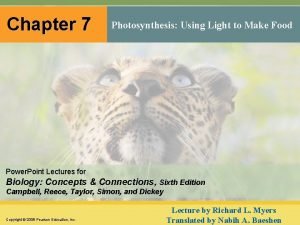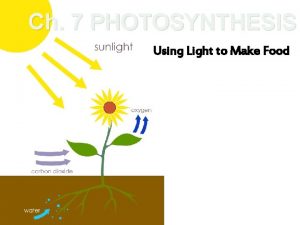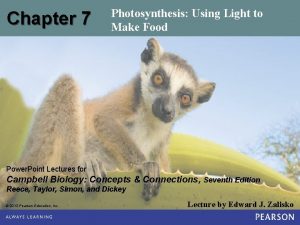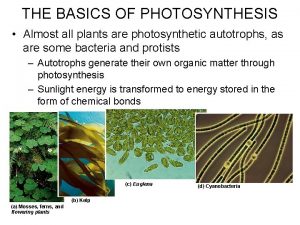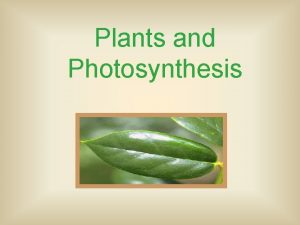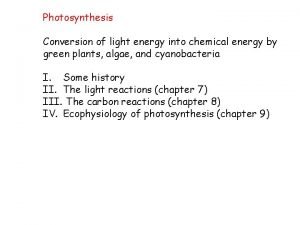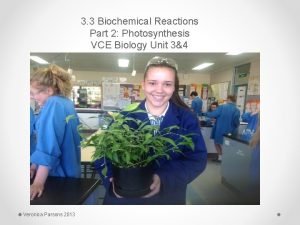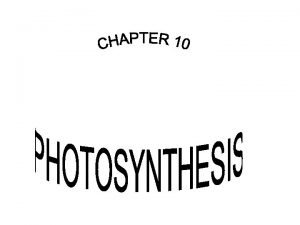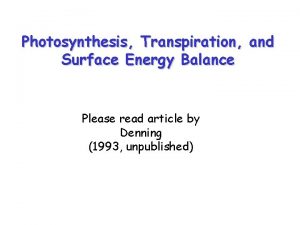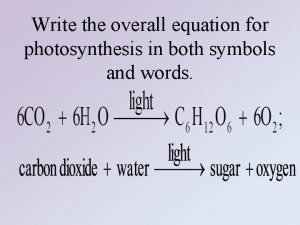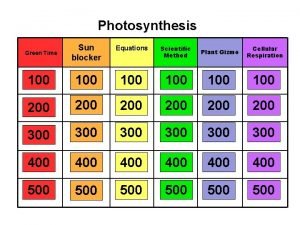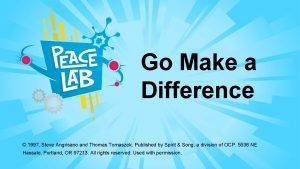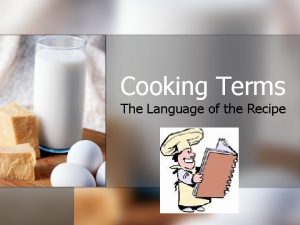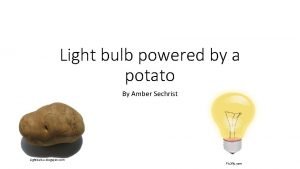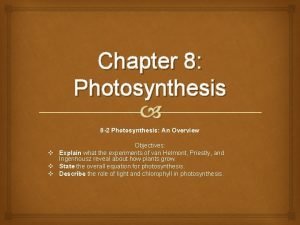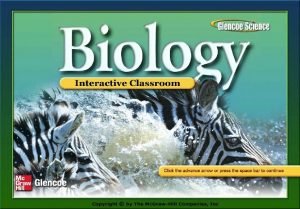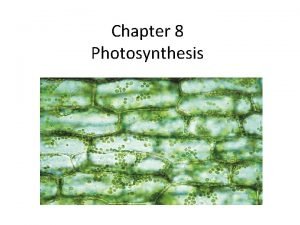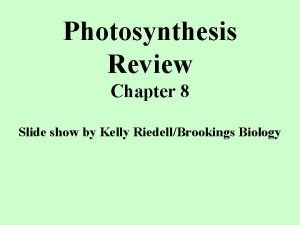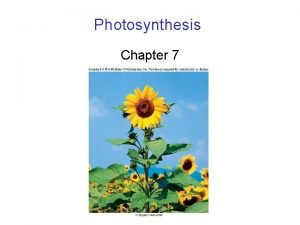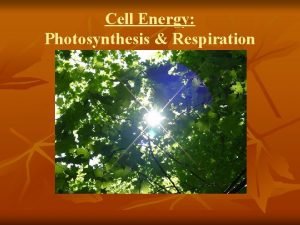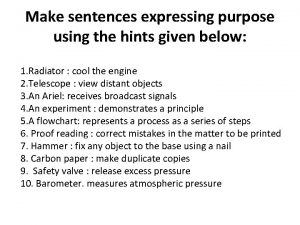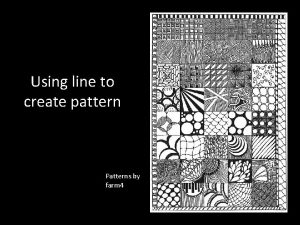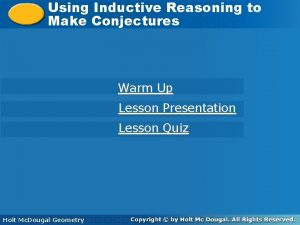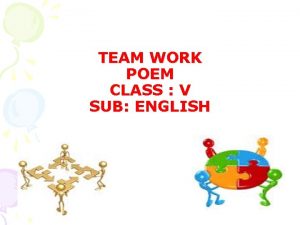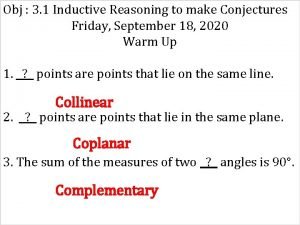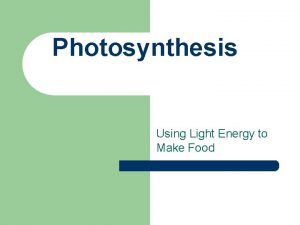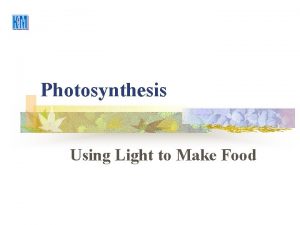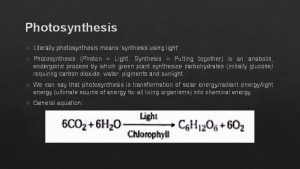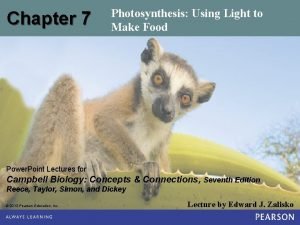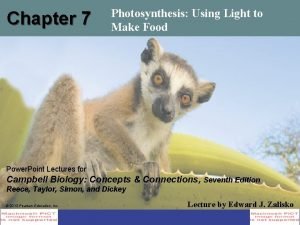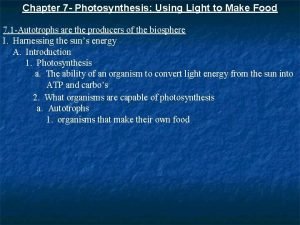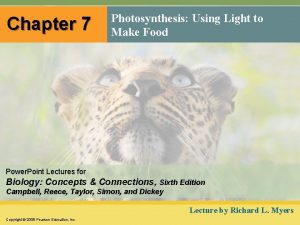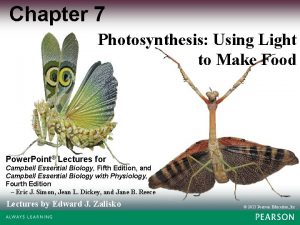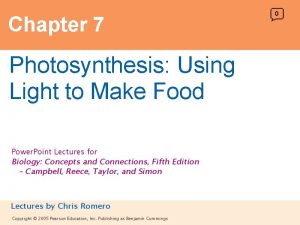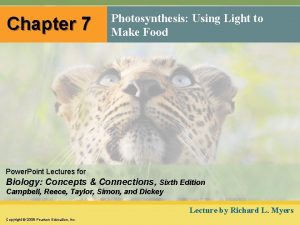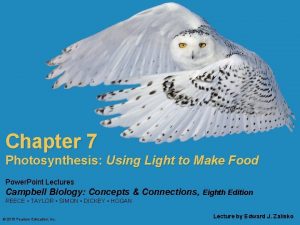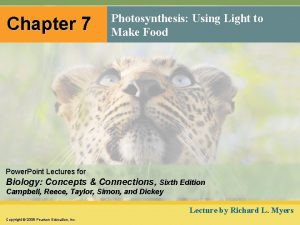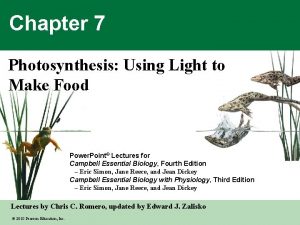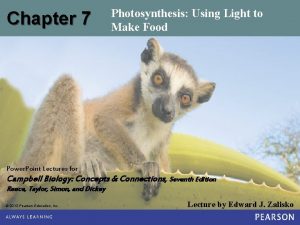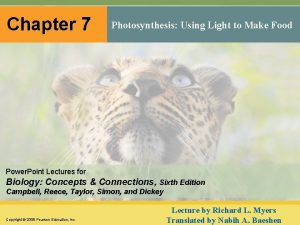CHAPTER 7 Photosynthesis Using Light to Make Food










































- Slides: 42

CHAPTER 7 Photosynthesis: Using Light to Make Food Overview: Photosynthesis Light Reactions Calvin Cycle Review of photosynthesis & C 3, C 4, CAM plants Greenhouse effect Ozone Layer

Life in the Sun • Light is central to the life of a plant • Photosynthesis is the most important chemical process on Earth – It provides food for virtually all organisms • Plant cells convert light into chemical signals that affect a plant’s life cycle • All of the food consumed by humans can be traced back to photosynthetic plants

• Light can influence the architecture of a plant – Plants that get adequate light are often bushy, with deep green leaves – Without enough light, plants become tall and spindly with small pale leaves • Too much sunlight can damage a plant – Chloroplasts and carotenoids help to prevent such damage

THE BASICS OF PHOTOSYNTHESIS • Almost all plants are photosynthetic autotrophs (=self-feeders; they make their own food), as are some bacteria and protists – They generate their own organic matter through photosynthesis All organisms that produce org molecules from inorg molecules using light: photoautotrophs

• On land, plants such as oak trees and cacti are the predominant producers (produce their food supply)

• In aquatic environments, algae and photosynthetic bacteria are the main food producers

Overview of Photosynthesis • Photosynthesis is the process by which autotrophic organisms use light energy to make sugar and oxygen gas from carbon dioxide and water

Chloroplasts: Sites of Photosynthesis • Photosynthesis – Occurs in chloroplasts • Chloroplasts: – Are found in the cells of the mesophyll (green tissue in the interior of the leaf) – Contain stroma, a thick fluid – Contain thylakoids, membranous sacs (The thylakoids contain chlorophyll - Chlorophyll is the green pigment that captures light for photosynthesis) – (grana- singular granum-, stacks of thylakoids)

Plants produce O 2 gas by splitting water • The O 2 liberated by photosynthesis is made from the oxygen in water

Photosynthesis is a redox process, as is cellular respiration • Water molecules are split apart and electrons and H+ ions are removed, leaving O 2 gas – These electrons and H+ ions are transferred to CO 2, producing sugar

Photosynthesis is a two-step process – An Overview: Light Reaction & Calvin cycle • The light reactions convert solar energy to chemical energy & produce O 2 • The Calvin cycle makes sugar from carbon dioxide Calvin cycle

• Light Reactions

THE LIGHT REACTIONS: CONVERTING SOLAR ENERGY TO CHEMICAL ENERGY • Sunlight is a type of energy called radiation, or electromagnetic energy • The full range of radiation is called the electro-magnetic spectrum • Certain wavelengths of visible light drive the light reactions of photosynthesis

• Chloroplasts absorb light energy and convert it to chemical energy • Chlorophyll molecules absorb photons – Electrons in the pigment (chlorophyll) gain energy • Light behaves as photons, discrete packets of energy

Chloroplast Pigments • Chloroplasts contain several pigments – Chlorophyll a – Chlorophyll b – Carotenoids

Photosystems capture solar power • Photosystems consist of many light-harvesting complexes (containing chlorophyll a, b, and carotenoid that function as a light-gathering antenna) surrounding a reaction center.

• Reaction center: A protein complex that contains a chlorophyll a and a molecule called primary electron acceptor - a primary electron acceptor receives excited electrons from the reaction-center chlorophyll

Photosystems are 2 types that corporate in the light reaction; (photosystem II functions first) • Photosystem I: Chlorophyll a of the reaction center is P 700 (absorbs light with wavelength 700 nm) • Photosystem II: Chlorophyll a of the reaction center is P 680 (absorbs light with wavelength 680 nm)

• Let’s see how these 2 systems work together to generate ATP and NADPH. • Two types of photosystems cooperate in the light reactions

• An electron transport chain – Connects the two photosystems – Releases energy that the chloroplast uses to make ATP

In the light reactions, electron transport chains generate ATP, NADPH, and O 2 • Two connected photosystems collect photons of light and transfer the energy to chlorophyll electrons • The excited electrons are passed from the primary electron acceptor to electron transport chains – Their energy ends up in ATP and NADPH

• In photosystem I, electrons from the bottom of the cascade pass into its P 700 chlorophyll • Photosystem II regains electrons by splitting water, leaving O 2 gas as a by-product

• The light reactions in the thylakoid membrane To Calvin Cycle 1/ 2

Chemiosmosis powers ATP synthesis in the light reactions • The electron transport chains are arranged with the photosystems in the thylakoid membranes and pump H+ through that membrane – The flow of H+ back through the membrane is harnessed by ATP synthase to make ATP – In the stroma, the H+ ions combine with NADP+ to form NADPH

• The production of ATP by chemiosmosis in photosynthesis

• The Calvin Cycle

ATP and NADPH power sugar synthesis in the Calvin cycle • The Calvin cycle occurs in the chloroplast’s stroma – This is where carbon fixation takes place and sugar is manufactured

THE CALVIN CYCLE: MAKING SUGAR FROM CARBON DIOXIDE • The Calvin cycle – Functions like a sugar factory within a chloroplast – Regenerates the starting material with each turn

• The Calvin cycle constructs G 3 P using – carbon from atmospheric CO 2 – electrons and H+ from NADPH – energy from ATP • Energy-rich sugar is then converted into glucose

PHOTOSYNTHESIS REVIEWED AND EXTENDED

Review: Photosynthesis uses light energy to make food molecules • A summary of the chemical processes of photosynthesis

• Many plants make more sugar than they need – The excess is stored in roots, tuber, and fruits – These are a major source of food for animals

• C 3 plants – Use CO 2 directly from the air – Are very common and widely distributed • Most plants are C 3 plants, which take CO 2 directly from the air and use it in the Calvin cycle – In these types of plants, stomata on the leaf surface close when the weather is hot – This causes a drop in CO 2 and an increase in O 2 in the leaf

C 4 and CAM plants have special adaptations that save water • C 4 plants – Close their stomata to save water during hot and dry weather – Can still carry out photosynthesis • CAM plants – Open their stomata only at night to conserve water

• Some plants have special adaptations that enable them to save water – Special cells in C 4 plants —corn and sugarcane— incorporate CO 2 into a four-carbon molecule – This molecule can then donate CO 2 to the Calvin cycle

• The CAM plants—pineapples, most cacti — employ a different mechanism – They open their stomata at night and make a fourcarbon compound – It is used as a CO 2 source by the same cell during the day Night

PHOTOSYNTHESIS, SOLAR RADIATION, AND EARTH’S ATMOSPHERE

Human activity is causing global warming; photosynthesis moderates it • Due to the increased burning of fossil fuels, atmospheric CO 2 is increasing – CO 2 warms Earth’s surface by trapping heat in the atmosphere – This is called the greenhouse Sunlight effect

How Photosynthesis Moderates the Greenhouse Effect • Old-growth forests – Are important for lumber – Are important for moderating world climates

• Greenhouse gases are the most likely cause of global warming, a slow but steady rise in the Earth’s surface temperature – Destruction of forests may be increasing this effect • Because photosynthesis removes CO 2 from the atmosphere, it moderates the greenhouse effect – It swaps O 2 for CO 2 – Unfortunately, deforestation may cause a decline in global photosynthesis

• The O 2 in the atmosphere results from photosynthesis – Solar radiation converts O 2 high in the atmosphere to ozone (O 3) – Ozone shields organisms on the Earth’s surface from the damaging effects of UV radiation

• Industrial chemicals called CFCs have hastened ozone breakdown, causing dangerous thinning of the ozone layer Sunlight • International restrictions on these chemicals are allowing recovery
 The process of photosynthesis
The process of photosynthesis Photosynthesis using light to make food
Photosynthesis using light to make food Using light to make food
Using light to make food Light light light chapter 23
Light light light chapter 23 Into the light chapter 22
Into the light chapter 22 Chapter 22
Chapter 22 Two raw materials necessary for photosynthesis
Two raw materials necessary for photosynthesis Green plants make their own food by photosynthesis
Green plants make their own food by photosynthesis Inputs of light reactions in photosynthesis
Inputs of light reactions in photosynthesis Autotrophs self-feeder
Autotrophs self-feeder Photosynthesis equation light reaction
Photosynthesis equation light reaction How to measure photosynthesis
How to measure photosynthesis Photosynthesis reaction
Photosynthesis reaction Structure of chlorophyll
Structure of chlorophyll Photosynthesis transforms light energy into chemical energy
Photosynthesis transforms light energy into chemical energy Unit 2 food food food
Unit 2 food food food Sequence of food chain
Sequence of food chain Word equation for photosynthesis
Word equation for photosynthesis The food that plants produce during photosynthesis is
The food that plants produce during photosynthesis is Food web photosynthesis
Food web photosynthesis Make the lie big
Make the lie big Go make a difference in the world
Go make a difference in the world Make the lie big make it simple
Make the lie big make it simple To mix ingredients gently in a circular motion
To mix ingredients gently in a circular motion Light bulb potato
Light bulb potato Put out the light and then put out the light meaning
Put out the light and then put out the light meaning Difference between light dependent and light independent
Difference between light dependent and light independent It is the bouncing off of light
It is the bouncing off of light Block light in science
Block light in science Chapter 8 section 2 photosynthesis answer key
Chapter 8 section 2 photosynthesis answer key Cellular energy section 2 photosynthesis
Cellular energy section 2 photosynthesis Chapter 9 lesson 2 photosynthesis an overview
Chapter 9 lesson 2 photosynthesis an overview Chapter 8 photosynthesis vocabulary review
Chapter 8 photosynthesis vocabulary review What are the products of photosynthesis?
What are the products of photosynthesis? Chapter 7 photosynthesis
Chapter 7 photosynthesis How do plants get glucose
How do plants get glucose Make sentences using the past simple and past continuous
Make sentences using the past simple and past continuous Make sentences expressing purpose using the given hints
Make sentences expressing purpose using the given hints Making predictions with experimental probability
Making predictions with experimental probability Simple line patterns
Simple line patterns Using inductive reasoning to make conjectures answers
Using inductive reasoning to make conjectures answers A short tube or stick carried in a relay race
A short tube or stick carried in a relay race Using inductive reasoning to make conjectures
Using inductive reasoning to make conjectures
